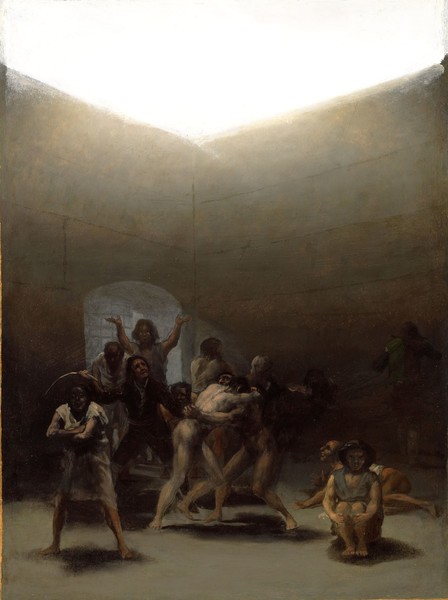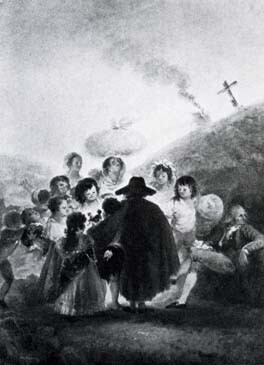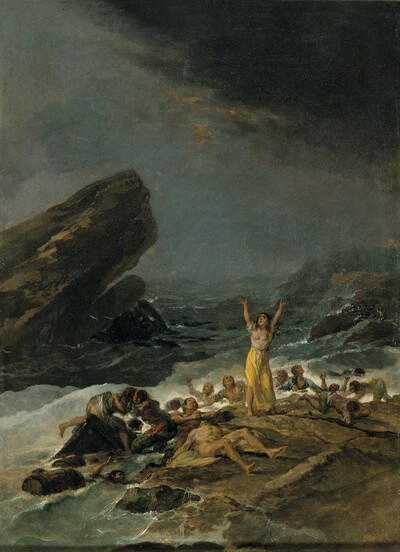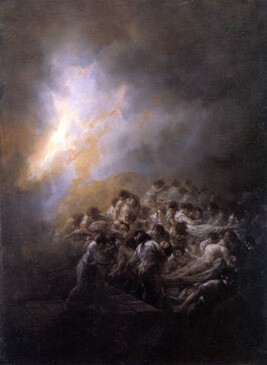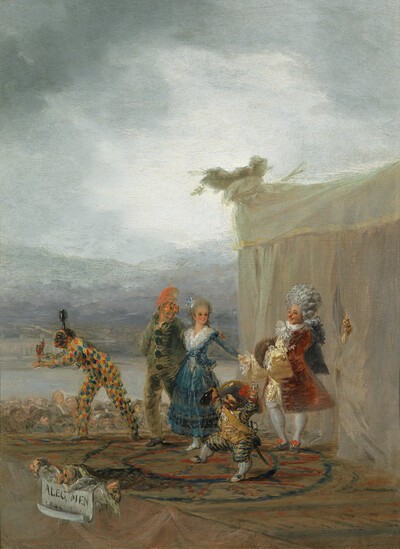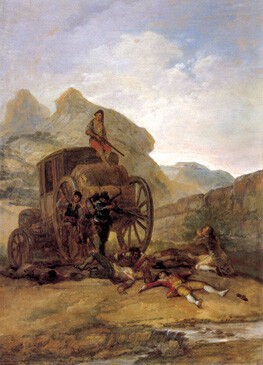- Cronología
- 1794
- Ubicación
- Meadows Museum, Southern Methodist University, Dallas, United States
- Dimensiones
- 43 x 32 cm
- Técnica y soporte
- Oil on tin
- Reconocimiento de la autoría de Goya
- Undisputed work
- Titular
- The Meadows Collection
- Ficha: realización/revisión
- 09 May 2010 / 14 Jun 2023
- Inventario
- (MM.67.01)
- Otros títulos:
-
Yard of a Madhouse (Patio en una casa de locos)
This work belonged to the Count of Quinto, who sold it in 1862. It subsequently belonged to a number of different collections, including those of: E.G. de Knyff, Edmond Picard, in Brussels, and a private collection in Paris.
It was finally bought by Algur H. Meadows who donated it to the American museum which has housed it since 1967.
This painting was identified in 1967 thanks to a description of it that appears in a letter which Goya sent to Bernardo de Iriarte on 7 January 1794: "(...) a yard with lunatics, in which two nude men are fighting whilst a warden beats them, and others dressed in sacks: (it is a scene that I witnessed in Zaragoza)". This is one of the works that Goya painted during his stay in Cádiz, spent at the home of his friend and ilustrado Sebastián Martínez, Bulls in the Meadow.
In a yard with no roof, possibly in a ward at the hospital of Nuestra Señora Gracia in Zaragoza, Goya has painted a group of mental patients. In the centre of the composition, two naked men are fighting as if they were a pair of Graeco-Roman wrestlers and look like something out of a classical painting or sculpture, whilst the carer or warden flogs them with a whip. Other men, dressed in the worn white tunics which Goya calls "sacks" in his letter, cheer them on. A figure on the left-hand side, standing with his arms crossed, looks straight out at the viewer with an expression of horror on his face, whilst the man wearing a hat, sitting on the ground to the right, jeers out at us. On the right-hand side, standing facing the wall, another figure wears the green and brown uniform given to less conflictive patients.
The bright light flooding in through the open roof and the barred window at the back of the scene blurs the outlines, resulting in an indistinct impression of the space and erasing the corner where the two walls of the yard meet. This gloomy, vague space in which the mental patients are held appears to be an allusion to the situation of these men, and to the confusion and chaos of their diminished capacity to understand or reason.
Goya here provides a glimpse into the deplorable conditions in which the mentally ill were forced to live, conditions which he himself tells us he witnessed first-hand. This work also deals with the subject of madness and irrationality, topics which he may have been drawn to following the loss of his hearing and which would go on to be of interest to the romantic painters, as we can see in works like The Madwoman (1822-1828, Musée des Beaux-Arts, Lyon), by Théodore Géricault (Rouen, 1791-Paris, 1821).
For more information, see Strolling Players.
-
GoyaKoninklijk Kabinet van Schilderijen MauritshuisThe Hauge1970organized by Ministerio de Estado y Asuntos Culturales and Réunion des Musées Nationaux, July 4th to September 13th 1970. Exhibited also at the Musée de l’Orangerie des Tuileries, Paris, October 25th to December 7th 1970, consultant editors Jeannine Baticle and A. B. de Vriescat. 15
-
Goya y el espíritu de la IlustraciónMuseo Nacional del PradoMadrid1988from October 6th to December 18th 1988. Exhibited also at Museum of Fine Arts, Boston, January 18th to March 26th 1989; The Metropolitan Museum of Art, Nueva York, May 9th to July 16th 1989, Madrid curator Manuela B. Mena Marqués, scientific directors Alfonso E. Pérez Sánchez and Eleanor A. Sayrepp. 48-49, cat. 21
-
Goya. El Capricho y la Invención. Cuadros de gabinete, bocetos y miniaturasMuseo Nacional del PradoMadrid1993from November 18th 1993 to February 15th 1994. Exhibited also at the Royal Academy of Arts, London, March 18th to June 12th 1994 and The Art Institute of Chicago, Chicago, July 16th to October 16th 1994, consultant editors Manuela B. Mena Marqués and Juliet Wilson-Bareaucat. 37
-
Painting in Spain in the Age of Enlightment: Goya and his contemporariesIndianapolis Museum of ArtIndianapolis1996from November 23th 1996 to January 19th 1997. Exhibited also at The Spanish Institute, Nueva York, Spring 1997, consultant editor Sarah Schrothcat. 50
-
Goya: Prophet der ModerneAlte NationalgalerieBerlin2005from July 13th to October 3th 2005. Exhibitied also at the Kunsthistorischemuseum, Vienna, October 18th 2005 to January 8th 2006, consultant editor Manuela B. Mena Marquéscat. 32
-
Goya en tiempos de guerraMuseo Nacional del PradoMadrid2008consultant editor Manuela B. Mena Marqués, from April 14th to July 13th 2008cat. 4
-
Goya: Order and disorderMuseum of Fine ArtsBoston2014cat. 172
-
Vie et ouvre de Francisco de GoyaParísOffice du livre1970p. 169, cat. 330
-
BarcelonaPolígrafa1970vol. I, p. 293, cat. 292
-
L’opera pittorica completa di GoyaMilanRizzoli1974p. 106, cat. 282
-
Goya and his CriticsNew Heaven-Londres: Yale University Press1977il. 20
-
Francisco de Goya, 4 vols.ZaragozaCaja de Ahorros de Zaragoza, Aragón y Rioja1980-1982vol. II, p. 110
-
Goya. Arte e condizione umanaNaplesLiguori editore1990pp. 74-75, il. 64
-
Goya. El capricho y la invención. Cuadros de gabinete, bocetos y miniaturasMadridMuseo del Prado1993pp. 200, 201, 202, 203 y 209 (il.), cat.
-
Goya y la locuraZaragoza2000pp. 20, 21, 22, 23, 24, 25 y 26
-
Los mundos de Goya (1746-1828)BarcelonaLunwerg2008p. 239, il. 142
-
Goya: Order & DisorderBostonMuseum of Fine Arts Boston Publications2014pp. 258-259
